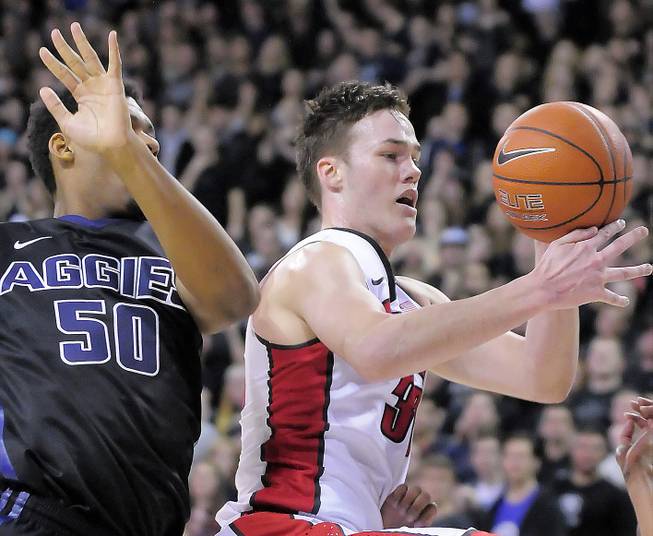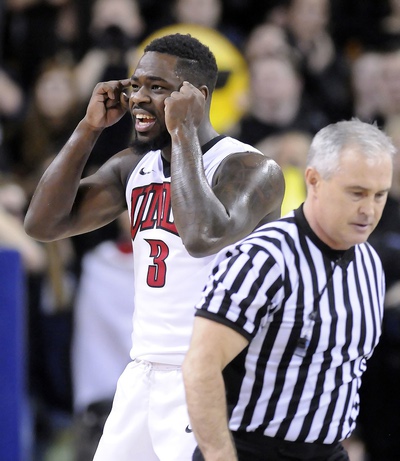
Eli Lucero / Herald Journal via AP
UNLV forward Stephen Zimmerman Jr. (33) grabs a rebound against Utah State forward Elston Jones (50) during the second half of an NCAA college basketball game, Tuesday, Jan. 19, 2016, in Logan, Utah.
Friday, Jan. 22, 2016 | 2 a.m.
The Rebel Room
Rebels Read to Flex?
UNLV played great in interim coach Todd Simon's first two games, and if that continues on the road this week the Rebels (11-7, 2-3) could really be in business. Las Vegas Sun sports editor Ray Brewer and reporters Case Keefer and Taylor Bern discuss what this UNLV team could do now that the pressure is off.
More Coverage
- Bern’s-Eye View: Mountain West Basketball Picks Week 10
- 'That’s who we are’: Rebels’ big run keys them to third straight victory
- Take 5: Rebels head to Utah State hunting for third straight victory
- Rebels hit century mark in dominant performance against Air Force
- Rebels run over Lobos 86-74 in Simon’s coaching debut
- Instant Analysis: This is how the Rebels were supposed to play all season
- The Sun's UNLV coverage
If momentum is a real thing the Rebels have it in full, and they plan to take it with them this weekend up north to UNR.
UNLV (12-7, 3-3) is looking for a fourth straight victory on Saturday when it tips off at 7 p.m. against the Wolf Pack (11-7, 3-3). The game will air on ESPNU.
For myriad reasons, nearly every player on the roster has shown some improvement in the past few games and the result has been high-scoring victories. Here’s a look at a few figures that have helped play a role in getting to this point:
7.4 — more minutes per game in conference play for Stephen Zimmerman Jr.
Between illness and injury, the highly touted freshman from Bishop Gorman High struggled to put together consistent games in a row in nonconference play in part because he struggled to stay on the court for several games in a row.
Zimmerman eclipsed 30 minutes four times in nonconference play and has already matched that through six conference games. That’s part of the reason people are seeing production like three straight double-doubles and a season-high in rebounding two of the last three games.
“The healthy part definitely helps out a lot, but I have been trying to be more aggressive and that’s mostly my teammates telling me that they need me to be more aggressive,” Zimmerman said.
Put them together and you have a scary combination that has the rest of the league’s frontcourts on notice. Zimmerman’s scoring hasn’t been a surprise and in fact there’s a lot of room for improvement from an effective field-goal percentage (45.2 percent) that ranks eighth on the team.
“There’s still room for growth,” Simon said. “That’s how talented he is.”
His rebounding and blocks are more important, though, and in those departments Zimmerman has been great. In conference games, his defensive rebounding rate (31.1 percent) leads the league while his block rate (7.8) ranks second.
As much as UNLV’s increased tempo is a credit to the pressure defense as a whole, a huge key to getting transition possessions has been Zimmerman cleaning things up and pushing the ball ahead.
“That position is oftentimes the anchor of the defense,” Simon said. “He sees everything and he’s got to talk through what’s going on. … A lot of it is quarterbacking the defense and he’s kind of come into his own in terms of being a vocal defensive player.”
The only guy ahead of Zimmerman in blocks is UNR 6-foot-8 freshman Cameron Oliver, who’s averaging 2.6 blocks per game for the season and a ridiculous 12.4 percent block rate in conference games. With the way that Zimmerman is now locked in (2.3 blocks per game in league play) and the way Oliver has played all season, on Saturday it might be more fair to award three points for shots at the rim rather than beyond the arc.
56.5 — Jordan Cornish’s 3-point shooting percentage the last eight games
Few expected Cornish to match the team-leading 48.7 percent he stroked from beyond the arc last season, but an equally small group would have predicted the abysmal shooting that could have doomed his sophomore campaign.
Over the first 10 games, Cornish hit 1-of-24 on 3-point attempts. Four percent.
You could feel how much his teammates were hoping to see a make with each heave, but as the misses piled up his confidence was visibly shaking. It occasionally affected other areas of his game, though not always, but it left coaches with a tough decision because opponents were backing off a guy who they needed to be an outside threat.
Then, the switch flipped, and with it one of the team’s emotional leaders started to flourish all over the court. The biggest key?
“Stop thinking so damn much,” Cornish said. “That’s it, just stop thinking and shoot the ball.”
The mental block had to dissolve before Cornish could move forward, and strangely enough it happened in the nonconference loss that ultimately led to Dave Rice’s ouster. Against Arizona State, Cornish went 2-for-3 from deep, and since then he’s hit 13-of-23 while making at least one 3-pointer in every game that he’s attempted one.
It helped that both publicly and privately the guys in scarlet and gray were behind him. The same way teammates were sometimes over-the-top rooting for his 3s from the bench during games, they also were in practice.
“My teammates were behind me the whole time,” Cornish said. “The coaching staff was behind me.”
Cornish has only gotten more comfortable under interim coach Todd Simon because the past two games he has spent some time at point guard. That’s where Cornish played in high school, and truth be told it’s what he would prefer.
“It gives me a great deal of confidence,” Cornish said. “I’m not a shoot-first guy, I would much rather get my teammates involved and take the open shot.”
Now when he does get that open look, everyone on both benches has to assume it’s going in.
.472 — points per possession allowed in isolation defense
That figure, which comes from Synergy Sports, is the second-best in the country. What’s equally important, though, is that only two teams in the top 20 have faced as much isolation offense as the Rebels (9.1 percent of possessions).
Being great at something doesn’t mean as much if you can’t get the opponent to play into it. That’s where UNLV’s denials have been big, because while that over-aggressive style exposes them to things like backdoor cuts, it also makes it harder for opponents to simply move the ball around.
“By taking teams out of their offense, it makes it very difficult to hit a wing or to get a ball reversal, which ultimately leads to a lot of one-on-one play,” Simon said.
Guarding without help is something the coaching staff has emphasized since practice began. Associate head coach Stacey Augmon runs the defense that ranks eighth nationally on kenpom.com and has tried to get every player to accept the challenge that they can’t be beat in isolation.
UNLV’s defense has been good all year but it seems to have stepped up a notch the past three games. Part of that is getting help when they need it — Zimmerman said his blocks have ticked up because guards are better at rotating to cover his man, leaving him free to go after the shot — but it comes down to each player executing in isolation.
“They’ve done a nice job embracing those one-on-one battles,” Simon said.
Taylor Bern can be reached at 948-7844 or [email protected]. Follow Taylor on Twitter at twitter.com/taylorbern.


Join the Discussion:
Check this out for a full explanation of our conversion to the LiveFyre commenting system and instructions on how to sign up for an account.
Full comments policy